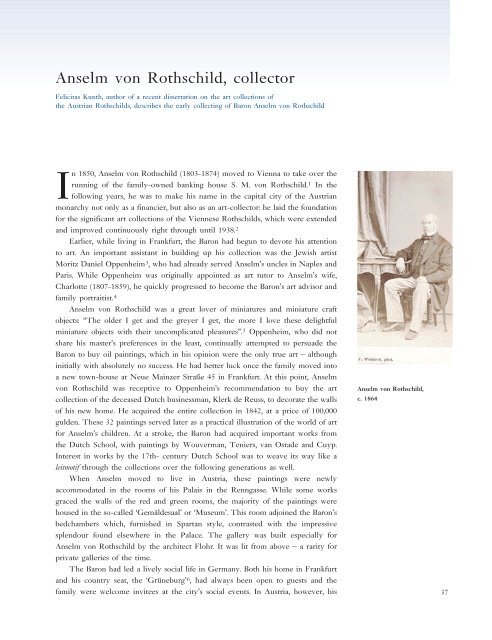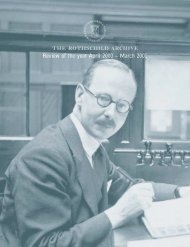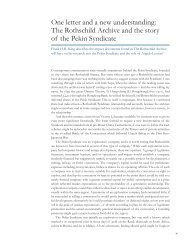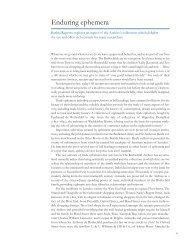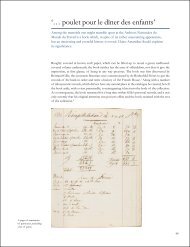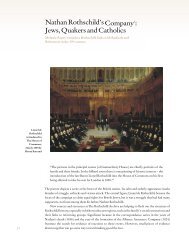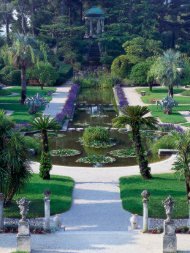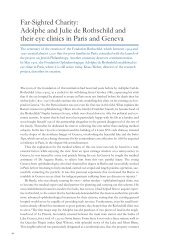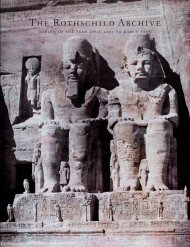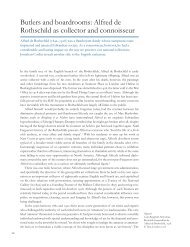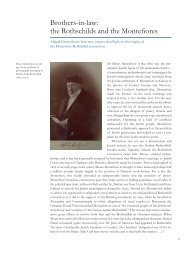Review of the Year April 2001 â March 2002 - The Rothschild Archive.
Review of the Year April 2001 â March 2002 - The Rothschild Archive.
Review of the Year April 2001 â March 2002 - The Rothschild Archive.
Create successful ePaper yourself
Turn your PDF publications into a flip-book with our unique Google optimized e-Paper software.
Anselm von <strong>Rothschild</strong>, collector<br />
Felicitas Kunth, author <strong>of</strong> a recent dissertation on <strong>the</strong> art collections <strong>of</strong><br />
<strong>the</strong> Austrian <strong>Rothschild</strong>s, describes <strong>the</strong> early collecting <strong>of</strong> Baron Anselm von <strong>Rothschild</strong><br />
In 1850, Anselm von <strong>Rothschild</strong> (1803-1874) moved to Vienna to take over <strong>the</strong><br />
running <strong>of</strong> <strong>the</strong> family-owned banking house S. M. von <strong>Rothschild</strong>. 1 In <strong>the</strong><br />
following years, he was to make his name in <strong>the</strong> capital city <strong>of</strong> <strong>the</strong> Austrian<br />
monarchy not only as a financier, but also as an art-collector: he laid <strong>the</strong> foundation<br />
for <strong>the</strong> significant art collections <strong>of</strong> <strong>the</strong> Viennese <strong>Rothschild</strong>s, which were extended<br />
and improved continuously right through until 1938. 2<br />
Earlier, while living in Frankfurt, <strong>the</strong> Baron had begun to devote his attention<br />
to art. An important assistant in building up his collection was <strong>the</strong> Jewish artist<br />
Moritz Daniel Oppenheim 3 , who had already served Anselm’s uncles in Naples and<br />
Paris. While Oppenheim was originally appointed as art tutor to Anselm’s wife,<br />
Charlotte (1807-1859), he quickly progressed to become <strong>the</strong> Baron’s art advisor and<br />
family portraitist. 4<br />
Anselm von <strong>Rothschild</strong> was a great lover <strong>of</strong> miniatures and miniature craft<br />
objects: “<strong>The</strong> older I get and <strong>the</strong> greyer I get, <strong>the</strong> more I love <strong>the</strong>se delightful<br />
miniature objects with <strong>the</strong>ir uncomplicated pleasures”. 5 Oppenheim, who did not<br />
share his master’s preferences in <strong>the</strong> least, continually attempted to persuade <strong>the</strong><br />
Baron to buy oil paintings, which in his opinion were <strong>the</strong> only true art – although<br />
initially with absolutely no success. He had better luck once <strong>the</strong> family moved into<br />
a new town-house at Neue Mainzer Straße 45 in Frankfurt. At this point, Anselm<br />
von <strong>Rothschild</strong> was receptive to Oppenheim’s recommendation to buy <strong>the</strong> art<br />
collection <strong>of</strong> <strong>the</strong> deceased Dutch businessman, Klerk de Reuss, to decorate <strong>the</strong> walls<br />
<strong>of</strong> his new home. He acquired <strong>the</strong> entire collection in 1842, at a price <strong>of</strong> 100,000<br />
gulden. <strong>The</strong>se 32 paintings served later as a practical illustration <strong>of</strong> <strong>the</strong> world <strong>of</strong> art<br />
for Anselm’s children. At a stroke, <strong>the</strong> Baron had acquired important works from<br />
<strong>the</strong> Dutch School, with paintings by Wouverman, Teniers, van Ostade and Cuyp.<br />
Interest in works by <strong>the</strong> 17th- century Dutch School was to weave its way like a<br />
leitmotif through <strong>the</strong> collections over <strong>the</strong> following generations as well.<br />
When Anselm moved to live in Austria, <strong>the</strong>se paintings were newly<br />
accommodated in <strong>the</strong> rooms <strong>of</strong> his Palais in <strong>the</strong> Renngasse. While some works<br />
graced <strong>the</strong> walls <strong>of</strong> <strong>the</strong> red and green rooms, <strong>the</strong> majority <strong>of</strong> <strong>the</strong> paintings were<br />
housed in <strong>the</strong> so-called ‘Gemäldesaal’ or ‘Museum’. This room adjoined <strong>the</strong> Baron’s<br />
bedchambers which, furnished in Spartan style, contrasted with <strong>the</strong> impressive<br />
splendour found elsewhere in <strong>the</strong> Palace. <strong>The</strong> gallery was built especially for<br />
Anselm von <strong>Rothschild</strong> by <strong>the</strong> architect Flohr. It was lit from above – a rarity for<br />
private galleries <strong>of</strong> <strong>the</strong> time.<br />
<strong>The</strong> Baron had led a lively social life in Germany. Both his home in Frankfurt<br />
and his country seat, <strong>the</strong> ‘Grüneburg’ 6 , had always been open to guests and <strong>the</strong><br />
family were welcome invitees at <strong>the</strong> city’s social events. In Austria, however, his<br />
Anselm von <strong>Rothschild</strong>,<br />
c. 1864<br />
37


